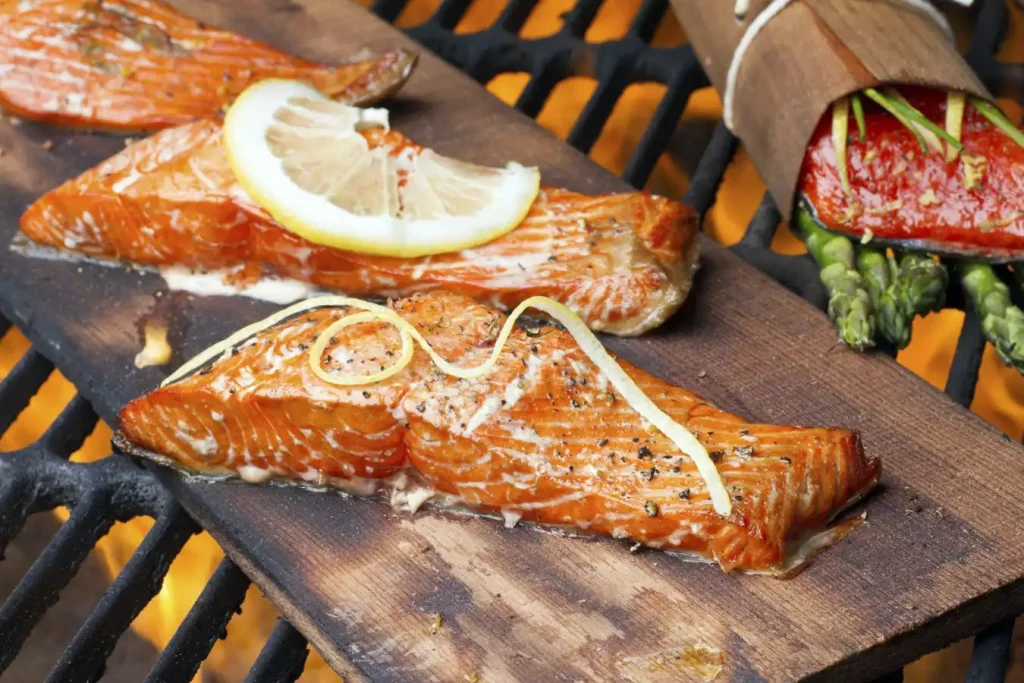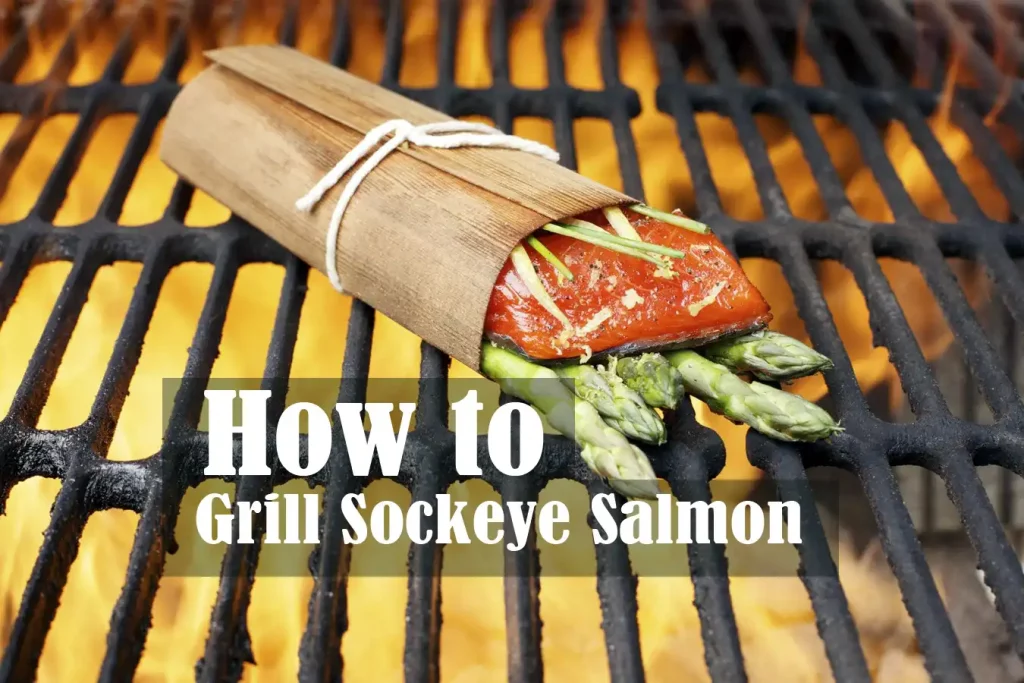Craving to know how to grill sockeye salmon to perfection in your own kitchen?
Welcome to your definitive guide.
As a passionate outdoor enthusiast and blogger who loves the authentic flavors of camp foods.
In this article, I’ll reveal the secrets of grilling that perfect sockeye salmon.
Through straightforward steps and insider tips, you’ll soon be grilling sockeye salmon to perfection.
So, are you ready to thrill your taste buds with this exquisite delight? Let’s get started!
Necessary Tools and Ingredients for Grilling Sockeye Salmon
Before we begin our grilling adventure, it’s essential to gather all the right tools and ingredients. With the right gear and the finest quality salmon, we’ll be all set to grill up a feast!
Grilling Tools You Will Need
First things first, you’re going to need a grill. Charcoal grills often offer the best flavor, but a gas grill works just as well. A grill brush is also handy to clean the grill grates before cooking. Furthermore, a fish spatula, which is wider and thinner than your regular spatula, will allow you to flip the fish without it breaking apart. Lastly, you’ll need a meat thermometer. Sockeye salmon is best when it’s not overcooked, and a reliable thermometer will help ensure you nail the perfect temperature.
Choosing Your Sockeye Salmon: Fresh or Frozen?
The star of the show is, of course, the sockeye salmon. When it comes to selecting your fish, you can opt for fresh or frozen. Fresh sockeye salmon offers a superb flavor profile, but it’s a seasonal delicacy, typically available from May to July.
However, high-quality frozen sockeye salmon can be just as delicious. What’s important is to ensure that the salmon has been handled and stored correctly. The color should be a vibrant red, and there should be no off smells.
Essential Ingredients and their Role in Enhancing Flavor
Now, let’s talk about the ingredients that will elevate your grilled sockeye salmon to the next level. Olive oil is necessary to prevent the fish from sticking to the grill. A sprinkle of sea salt and freshly cracked black pepper goes a long way in enhancing the natural flavor of the fish.
Citrus, such as lemon or lime, adds a zesty twist that balances the richness of the salmon. You can also include your favorite herbs like dill, rosemary, or parsley for an extra layer of flavor. Lastly, consider a brush of melted butter or a drizzle of honey for a gorgeous glaze that’ll give your salmon a beautiful, appetizing finish.
Preparing the Sockeye Salmon for Grilling
Preparing your sockeye salmon is just as crucial as the grilling process itself. It includes steps like thawing, cleaning, and marinating, all of which can significantly impact the taste and texture of your final product. So, let’s delve into these essential preparation stages.

Thawing Frozen Sockeye Salmon: Best Practices
If you’ve opted for frozen sockeye salmon, thawing it correctly is essential to preserve its quality and flavor. The best method is to thaw it slowly in the refrigerator. Simply move your salmon from the freezer to the fridge 24 hours before you plan to cook it. This slow, gentle thawing process helps retain the fish’s texture and moisture.
However, if you’re short on time, you can use the cold water thawing method. Place the frozen salmon in a sealed plastic bag and submerge it in cold water, changing the water every 30 minutes until it’s thawed.
Cleaning and Prepping Your Sockeye Salmon
Once your salmon is thawed, it’s time to clean and prep it. Rinse it under cold water and pat dry with paper towels. Remove any remaining scales or bones. If you prefer, you can ask your fishmonger to do this for you.
However, be sure to leave the skin on. The skin acts as a protective barrier between the fish and the grill, preventing it from drying out and sticking to the grates.
Marinating the Sockeye Salmon: Recipe and Method
Now comes the fun part: marinating the salmon. This is where you can get creative. A simple marinade could be olive oil, lemon juice, minced garlic, chopped dill, salt, and pepper. Mix these ingredients in a bowl, place your salmon in a dish or ziplock bag, and pour the marinade over it.
Let it sit in the fridge for at least 30 minutes to an hour. Not too long though, as the acidity from the lemon can start to “cook” the fish, altering its texture.
How to Grill Sockeye Salmon: The Grilling Process
With your sockeye salmon prepped and marinated, it’s finally time to fire up the grill! The grilling process can be an art in itself, but with the right tips, you’ll master it in no time. Let’s walk you through the steps.
Preheating the Grill: Charcoal vs. Gas Grill
Preheating your grill is a crucial first step. For a charcoal grill, this might take about 20 minutes. You’re aiming for a medium heat of around 375-400 degrees Fahrenheit. If you’re using a gas grill, preheat it on high for 10-15 minutes, then reduce the heat to medium before placing your salmon.
Placing the Salmon on the Grill: Skin-side Down or Up?
Next, lightly oil your grill grates to prevent sticking and place your salmon on the grill, skin-side down. Why? Because it’s easier to flip the salmon once the skin side is nice and crispy. Plus, the skin also protects the flesh from the intense heat, keeping it juicy and moist.
Monitoring the Cooking Time: How to Know When It’s Done
Cooking time can vary depending on the thickness of your salmon and the heat of your grill. However, a good rule of thumb is about 4-5 minutes per side for a one-inch thick fillet. The salmon is ready when it flakes easily with a fork, and its internal temperature reaches 145 degrees Fahrenheit when checked with a meat thermometer.
Serving the Grilled Sockeye Salmon
Now that you’ve mastered the art of grilling sockeye salmon, it’s time to enjoy the fruits of your labor! But serving your masterpiece is more than just placing the fish on a plate. It involves letting it rest, pairing it with the right sides and wines, and storing any leftovers. So let’s dive right in.
Letting the Salmon Rest: Why it’s Crucial
Just like with other meats, letting your salmon rest after it’s off the grill is a crucial step many home cooks overlook. Resting allows the juices to redistribute throughout the salmon, ensuring a moist and flavorful bite. You don’t need to let it rest for long, though. Just 3-5 minutes will do the trick. This is the perfect time to gather your sides and set the table.
Serving Suggestions: Accompaniments and Wine Pairings
Sockeye salmon has a rich, full flavor that pairs well with a variety of sides. For a light summer meal, you might opt for a refreshing cucumber salad or steamed asparagus. If you’re aiming for something more hearty, roasted potatoes or wild rice are great options. As for wine, choose something that can balance out the salmon’s richness. A dry rosé or a crisp white wine like Sauvignon Blanc or Pinot Grigio would be perfect.
Storing Leftovers: Proper Storage and Reheating Tips
If you’re lucky enough to have leftovers, make sure to store them properly. Place the leftover salmon in an airtight container and refrigerate it within two hours of cooking. When you’re ready to enjoy it again, reheat gently in the oven at a low temperature to prevent drying out. Or better yet, enjoy it cold in a salad or sandwich.
Learn more: Cook Shrimp on the Grill Without Skewers
Common Mistakes to Avoid When Grilling Sockeye Salmon
While grilling sockeye salmon is not overly complex, there are common pitfalls that can affect the outcome. Being aware of these mistakes and learning how to avoid them can help ensure your grilling success.
Overcooking the Salmon: How to Avoid
Overcooking can turn your succulent sockeye salmon into a dry, flaky mess. To avoid this, keep a close eye on your salmon during the grilling process. Use a meat thermometer to check the internal temperature, which should be 145 degrees Fahrenheit at its thickest part. And remember, it will continue to cook a bit more once it’s off the grill!
Not Using Enough Oil: The Importance of Moisture
Not using enough oil can lead to your salmon sticking to the grill grates. To prevent this, generously oil both the salmon and the grill grates before you start cooking. Using a marinade or brushing your salmon with oil during cooking can also help keep it moist and prevent sticking.
Grilling at Incorrect Temperatures
Grilling your salmon at too high a temperature can lead to the outside burning before the inside is fully cooked, while too low a temperature can leave your salmon undercooked and lacking that desirable grilled flavor. Aim for a medium heat of around 375-400 degrees Fahrenheit for the best results.
By keeping these tips and tricks in mind, you’ll be on your way to grilling sockeye salmon to perfection every time.
Read more: How to Smoke Salmon on a Grill
FAQs about Grill Sockeye Salmon
How long does salmon need to be on the grill?
Salmon generally needs to be grilled for about 4-6 minutes per side, depending on its thickness and your preferred level of doneness.
How long to grill sockeye salmon in foil?
Grilling sockeye salmon in foil typically takes about 15-20 minutes at 375 degrees Fahrenheit.
How do you know when sockeye salmon is done?
Sockeye salmon is done when it reaches an internal temperature of 145 degrees Fahrenheit at the thickest part, or when the flesh flakes easily with a fork.
Do you have to flip salmon on the grill?
While it's not necessary to flip salmon on the grill, doing so can help achieve even cooking and a crispy crust on both sides. If you prefer, you can simply grill it skin-side down for the entire cook time.
Final Thoughts about to Grill Sockeye Salmon
Grilling sockeye salmon can be a satisfying endeavor with scrumptious rewards. With a bit of preparation, the right tools, a high-quality salmon, and attention to detail, you can turn a simple piece of fish into an extraordinary meal.
Now that you’ve mastered these steps, your grilling adventures can extend beyond sockeye salmon. Who knows, perhaps halibut is next on your list! So fire up that grill and get cooking. Your taste buds will thank you.
Read more: How to Use Charcoal in a Gas Grill


